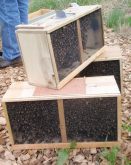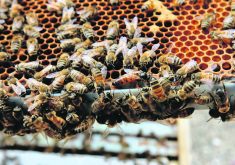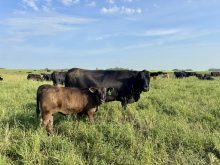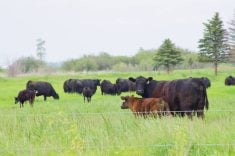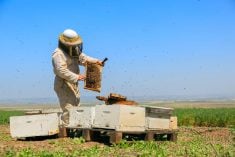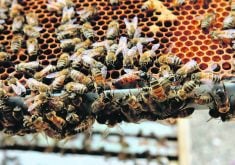Beekeepers reported high losses over the winter and experts are exploring the reasons and seeking ways to mitigate future colony declines.
Ian Steppler, president of the Manitoba Beekeepers Association, said Manitoba’s losses this year are extremely high.
“We’re nearly at a 60 per cent loss right across Manitoba right now, the highest loss in Canada by at least five per cent,” he said.
The conversation over decline in honey bee numbers is not new. Entomologists have been talking about colony collapse disorder for decades. It’s an important topic not only for beekeepers but for farmers who rely upon the insects as natural pollinators. Another year of significant losses brings the subject to the forefront once again.
Read Also

Finally getting paid for sustainable farming?
Alberta project says they might have a line on a workable ecosystem credit model to reward farmers for sustainability, and Manitoba might be next
Steppler was one of three experts who gathered for an online discussion about the pollinator situation in the province. He was joined by Dr. Rob Currie, a professor and head of the University of Manitoba’s entomology department who specializes in honey bees, and Dr. Jason Gibbs, an associate professor in the entomology department, whose expertise lies in native bee species.
Predator
The oft-cited villain of honeybee colony losses is the varroa mite. A varroa mite infestation occurs when a female mite enters a honey bee brood cell. The mite lays eggs on the larva. When the bee emerges after pupation, the varroa mites also leave and spread to other bees and larvae.
“It’s a very large mite, not unlike a wood tick,” Currie said.
From the bee’s perspective, “it’s the equivalent of having a wood tick the size of a dinner plate on your body.”
While there are a number of factors that play into colony losses, such as nutrition, environment, climate and pesticides, the varroa mite is the number one culprit when it comes to colony losses.
“It’s kind of like the straw that broke the camel’s back,” Currie said. “If you could eliminate the mite from the equation, you wouldn’t necessarily eliminate the problem, but I think it would greatly improve our ability to manage bees successfully.”
Before the varroa mite became prevalent in Manitoba, there was occasionally poor colony survival and the odd disaster, but nothing like what’s been seen since the mite came on to the scene in Canada in the early 1990s.
Other issues
Nevertheless, other stressors also have an impact.
“You can’t always pin it down to one thing for all producers,” Currie said. “One producer might have a mite problem, another might have a nutrition problem, and another might have a feed problem. The environment is something we can’t control. But it definitely kicks us in the head every once in a while.”
Steppler, a beekeeper who runs a 1,200–1,500 hive apiary on his family’s 3,500 acre farm near Miami, agrees that varroa mites are a problem but this year’s colony losses were much worse than a normal year. The reasons stem from the hot, dry summer of 2021.
The drought that spanned the Prairies saw wildfires fill the air with smoke, which created a stressful environment for bees. Steppler speculates that the drought led to plants providing less nutrition to the bees so they were malnourished as they transitioned into winter. And just as the bees were settling into winter, the climate dealt another blow.
“If you drove across the countryside in Manitoba in October, we had fields of canola in full bloom. We had more flowers in October than we actually had in July because of the drought,” he said, nothing that late flowering reignited the colonies.
“They actually started transitioning out of those winter nests back into almost a summertime nest and they began brooding up again,” Steppler said, and that process allowed varroa mites to re-establish as well. The cold spring of 2022 didn’t help matters.
“It’s almost like beekeepers got kicked and were on the ground when Mother Nature came and gave them another hoof to the gut again just to finish them off,” he said.
Native bees
When most people think of bees, they think of honey bees or bumblebees. But Gibbs points out there are more than 20,000 species of bees of which 250 are bumblebees and about nine are honey bees. And honey bees behave differently than most species.
“A very typical bee would be solitary,” Gibbs said. “They don’t have colonies at all. There’s no queens or workers, just a single female.”
He says as many as 70 per cent nest in the ground. Most people, if they noticed at all, might mistake it for an ant’s nest. Most bee species are indifferent to humans and they don’t sting.
“They’ll completely ignore you. And most of us go through our entire lives without noticing them at all,” said Gibbs.
Nevertheless, native bees are also under pressure and it’s even more concerning because they don’t have human benefactors working to replenish losses.
“Some native bumblebees have undergone pronounced declines in the last two decades and are even ranked on endangered species lists,” Gibbs said, citing the rusty-patch bumblebee as an example. And while they can still be found in Manitoba, the yellow-banded bumblebee has become a species of conservation concern over that same period.
Gibbs said there is simply not enough data to say with confidence that the status of native bee species has changed. This is partially due to challenges in identifying them and sparse historical records.
“My students and I recently rediscovered a bee in Manitoba, Epeoloides pilosulus, which hadn’t been collected in Manitoba in 95 years,” he said. “This species has been ranked as endangered but it’s hard to say what its populations have been doing in the last century with records so few and far between.”
The reasons for population declines in native bees are also different from those for honey bees. For one thing, they are not susceptible to varroa mite infestations. However, declines in native bee species are actually a much bigger problem.
“The concerns regarding native bees are often much greater than those regarding honey bees,” Gibbs said. “Honey bees in North America are not native, so annual losses are an economic concern but not an ecological one.”
For native bees, the changing landscape is the most important driver for population losses.
“Some bees are specialists. They’ll only visit willows or they’ll only visit sunflowers,” he said.
As a result, their livelihood is heavily reliant on diversity in the landscape.
The lack of ecological diversity caused by monoculture agriculture, amplified by modern agricultural tools and chemicals, is often blamed for declines in both native and honey bee populations.
Because he straddles the line between crop/cattle farmer and beekeeper, Steppler has a nuanced approach to this argument.
“We use all these technologies on our farm also,” said Steppler. “I won’t say GM technology or Roundup Ready technology is killing the bees. I’d say more so, it’s that GM and Roundup Ready technology are stripping the landscape of diversity.”
Steppler is trying to strike a balance on his farm to address that biodiversity deficit while remaining profitable and productive.
“We need these efficiencies and these technologies, but it doesn’t mean that we can’t focus on little things that contribute to what we’re lacking,” he said.
Some of those “little things” include planting flowers in ditches for the bees, or sprinkling clover, which has nutritious pollen and high yielding nectar, in pastures where cattle feed.
“The cows eat the grass first, and then they munch on the clover,” Steppler said. “We rotate them out, get a rain and the clover regenerates.”
This rotation gives the bees an opportunity to constantly feed on the clover.
“It doesn’t provide enough for a crop, but it provides enough nutrition for the bees to be able to maintain and develop themselves.”
On the research end of things, Currie said he hopes to come up with diagnostic tools that will help beekeepers identify the causes of colony loss. Researchers are also working on breeding bees to better deal with stressors.
“We’re trying to create locally adapted stock that’s really well suited to our conditions that has resistance to some of these pests and parasites that we find inside the hives.”




